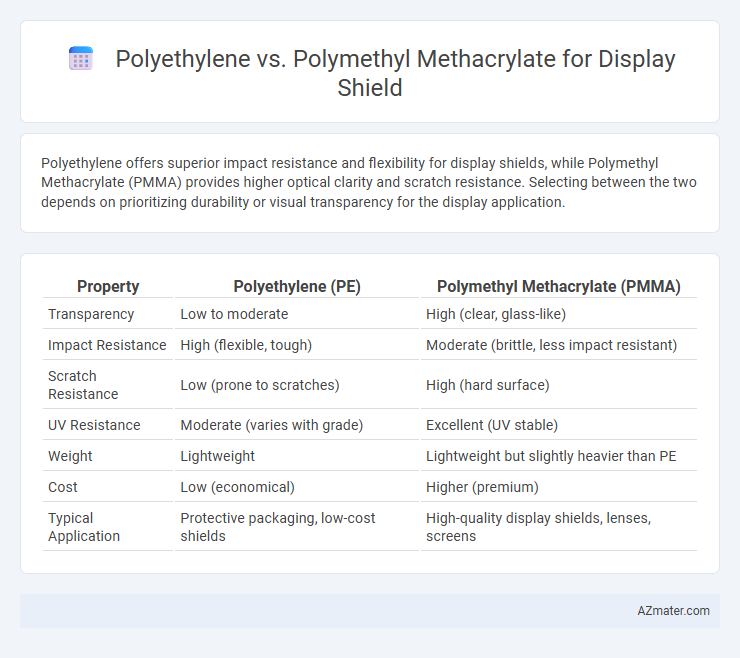Polyethylene offers superior impact resistance and flexibility for display shields, while Polymethyl Methacrylate (PMMA) provides higher optical clarity and scratch resistance. Selecting between the two depends on prioritizing durability or visual transparency for the display application.
Table of Comparison
| Property | Polyethylene (PE) | Polymethyl Methacrylate (PMMA) |
|---|---|---|
| Transparency | Low to moderate | High (clear, glass-like) |
| Impact Resistance | High (flexible, tough) | Moderate (brittle, less impact resistant) |
| Scratch Resistance | Low (prone to scratches) | High (hard surface) |
| UV Resistance | Moderate (varies with grade) | Excellent (UV stable) |
| Weight | Lightweight | Lightweight but slightly heavier than PE |
| Cost | Low (economical) | Higher (premium) |
| Typical Application | Protective packaging, low-cost shields | High-quality display shields, lenses, screens |
Introduction to Display Shield Materials
Polyethylene and Polymethyl Methacrylate (PMMA) are widely used materials for display shields, each offering distinct properties suitable for various applications. Polyethylene delivers excellent impact resistance and flexibility, making it ideal for rugged environments requiring durable protection. PMMA, known for its superior optical clarity and scratch resistance, provides high transparency and aesthetic appeal essential for premium display shields in consumer electronics.
Overview of Polyethylene Properties
Polyethylene (PE) offers excellent impact resistance and flexibility, making it a durable choice for display shields exposed to daily wear and tear. Its chemical resistance and low moisture absorption contribute to long-lasting clarity and protection against environmental factors. Compared to polymethyl methacrylate (PMMA), polyethylene exhibits superior toughness but generally lower optical transparency and scratch resistance.
Overview of Polymethyl Methacrylate (PMMA) Properties
Polymethyl methacrylate (PMMA) is a transparent thermoplastic often used as a lightweight and shatter-resistant alternative to glass for display shields. It exhibits excellent optical clarity with up to 92% light transmittance, superior weather resistance, and good UV stability, making it ideal for outdoor and high-visibility applications. PMMA also provides high surface hardness and scratch resistance compared to polyethylene, ensuring durability and long-lasting aesthetics in protective display covers.
Comparative Mechanical Strength
Polyethylene exhibits moderate tensile strength and high impact resistance, making it suitable for flexible or curved display shields where durability against shocks is essential. Polymethyl Methacrylate (PMMA) offers superior rigidity and higher tensile strength but is more brittle, providing excellent scratch resistance for flat, rigid display applications that demand optical clarity. The choice between polyethylene and PMMA for display shields depends largely on the required balance between impact resistance and hardness, with PMMA favored for scratch resistance and polyethylene preferred in impact-prone environments.
Optical Clarity and Light Transmission
Polymethyl Methacrylate (PMMA) exhibits superior optical clarity and light transmission compared to Polyethylene, making it the preferred choice for display shields requiring high transparency. PMMA allows over 92% light transmission with minimal haze, ensuring vivid and sharp visuals, while Polyethylene typically shows lower transparency and higher light scattering. The enhanced refractive properties of PMMA contribute to better color accuracy and reduced glare in display applications.
Resistance to Impact and Scratches
Polyethylene offers superior resistance to impact due to its high toughness and flexibility, making it ideal for display shields requiring durability against drops and shocks. Polymethyl Methacrylate (PMMA), although less impact-resistant, excels in scratch resistance with its hard, rigid surface that maintains clarity over time. For applications demanding robust protection against both impacts and scratches, combining polyethylene's impact absorption with PMMA's surface hardness often results in optimal display shield performance.
UV Stability and Weather Resistance
Polyethylene exhibits moderate UV stability and weather resistance but tends to degrade and yellow over prolonged exposure to sunlight, limiting its effectiveness as a display shield material. Polymethyl methacrylate (PMMA) offers superior UV resistance and maintains clarity under harsh environmental conditions, making it more suitable for outdoor display applications. PMMA's enhanced weather resistance and optical properties ensure long-term durability and visual performance compared to polyethylene.
Ease of Fabrication and Customization
Polyethylene offers excellent ease of fabrication due to its low melting point and flexibility, allowing for simple molding and cutting processes ideal for custom display shield shapes. Polymethyl Methacrylate (PMMA) provides superior clarity and rigidity but requires more precise temperature control and techniques such as CNC machining or laser cutting for customization. The trade-off between polyethylene's versatile handling and PMMA's premium optical properties should guide material selection based on fabrication capabilities and display shield requirements.
Cost Comparison and Availability
Polyethylene offers a significantly lower material cost compared to Polymethyl Methacrylate (PMMA), making it a budget-friendly choice for display shields in high-volume production. While PMMA provides superior optical clarity and scratch resistance, its higher price and limited availability due to more complex manufacturing processes can increase overall project expenses. Polyethylene's widespread availability and ease of processing contribute to faster lead times and reduced costs, beneficial for cost-sensitive applications requiring durable display protection.
Choosing the Right Material for Display Shields
Polyethylene offers excellent impact resistance and flexibility, making it suitable for protective display shields that require durability and lightweight properties. Polymethyl Methacrylate (PMMA), known for its superior optical clarity and scratch resistance, provides a glass-like appearance ideal for high-visibility screens. Selecting the right material for display shields depends on balancing impact strength, transparency, and environmental exposure to ensure optimal protection and visual performance.

Infographic: Polyethylene vs Polymethyl Methacrylate for Display Shield
 azmater.com
azmater.com